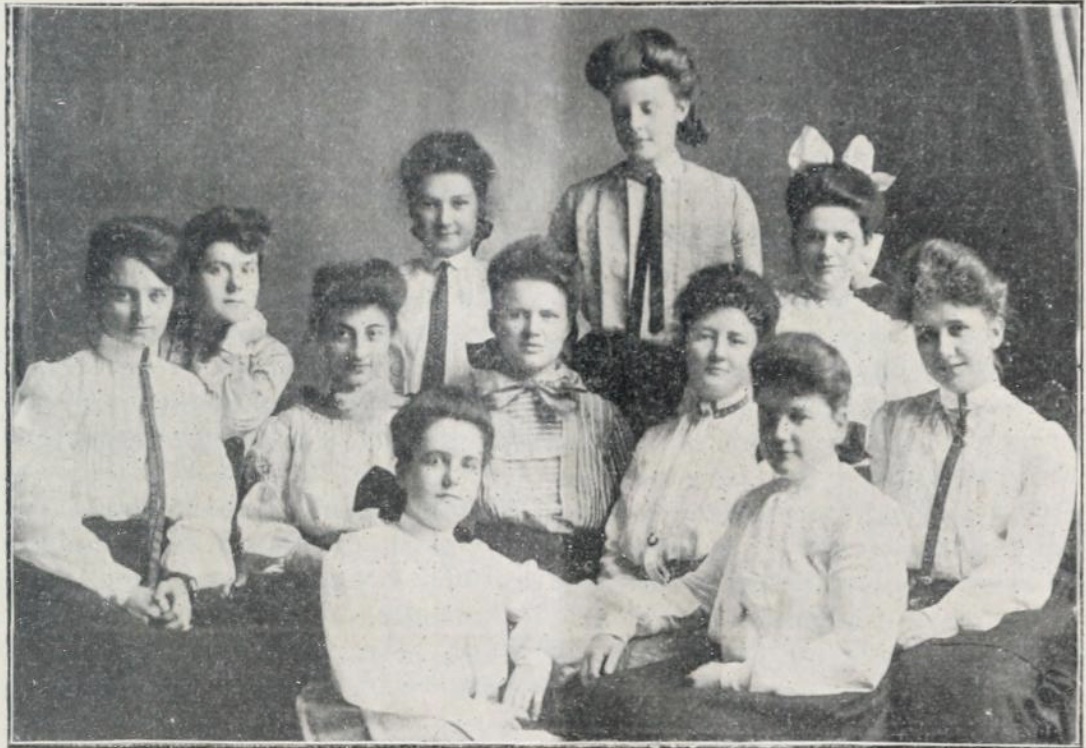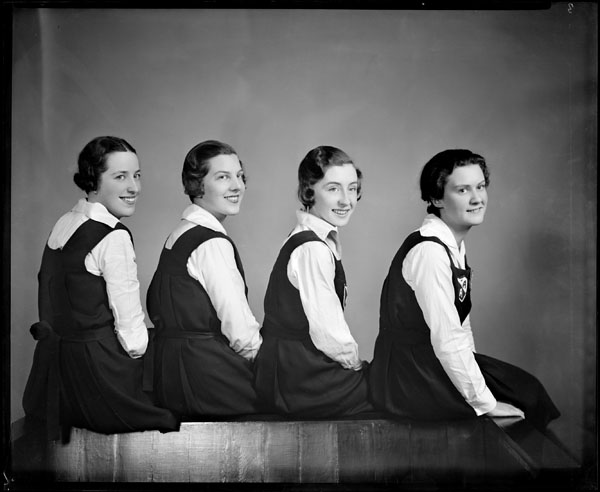Opened in 1872, the Ottawa Ladies’ College (OLC) was originally located on the southwest corner of Albert and Bay Streets before moving to its First Avenue location in 1914. Established as the expressed desire of many “earnest Protestant gentlemen” (including timber baron Henry Bronson) who represented the citizens of Ottawa and residents of Canada in their petition to form a school. The basis of this petition was to have a “first-class education put within the reach of the young women of the City of Ottawa and vicinity.” [2]
While private educational institutions, like convent schools and the Young Ladies’ Academy (founded in 1861) provided education to young women in Ottawa before the OLC was founded, what set the OLC apart was the designation as a college which provided education at the primary, secondary and collegiate levels. [3]
 [Fig.2] The editors of the O.L.C. Echoes (student journal) April 1905 issue - University of Toronto Robarts Library Internet Archive Collection.
[Fig.2] The editors of the O.L.C. Echoes (student journal) April 1905 issue - University of Toronto Robarts Library Internet Archive Collection.
A primary aim of ladies’ colleges was to “assist in the moulding of character [and]. . . to afford refining influences.” [4] As the 1879 edition of the OLC school calendar states, this type of education offered a “good English education, together with the with the usual polite accomplishments for young women, under sound Evangelical, though non-sectarian influences.” [5] Ladies’ Colleges emphasized training in languages, classical studies, domestic science, fine arts and music. While at the same time, bookkeeping and stenography, mathematics and science were also included in the curriculum, particularly at the upper levels.
Though emphasis continued to be placed on education to further gendered social responsibilities, print media related to the promotion of the school reflects the OLC’s acknowledgment of the widening number of spheres in which women actively participated. As a 1921 article from the Ottawa Citizen articulates, the program of education adopted by the college was well-rounded, with the “aim of developing strong, intelligent, cultured and useful womanhood,” stating that “the commercial department provides a thorough business education; while in household arts, instruction is given in the most capable and efficient methods of keeping a home.” [6]
In addition to educational endeavours, the school boasted active social life for its students. Student organizations included the May Court Club (founded in 1898 by Lady Aberdeen), the Literary and Dramatic Club and the Athletic Association. Following their time at the college, alumnae maintained social connections through groups such as the Literacy Circle of the Alumnae Association.
 [Fig.3] Ottawa Ladies College Athletic Association (April 13, 1934) - Yousuf Karsh, Yousuf Karsh fonds, Library and Archives Canada, Accession 1987-054, e010678972.
[Fig.3] Ottawa Ladies College Athletic Association (April 13, 1934) - Yousuf Karsh, Yousuf Karsh fonds, Library and Archives Canada, Accession 1987-054, e010678972.
In 1942, the college decided to close following the takeover of the building by the Women’s Army Corps. Reflecting upon the legacy of the school, Chairman Colin Frasier Elliott told The Ottawa Journal that, graduates of the school have “gone out with a clearer recognition of their own reasonability as members of the community and the intensified desire to render service.” [7] In July 1942, in recognition of the “renowned institution,” the Women’s Canadian Historical Society of Ottawa displayed more than 125 photographs at the Bytown Museum which spanned the OLC’s seventy-year history. At the time of this exhibit, Mrs. James R. Dickson (who was an Alumnae of the college) was president of the Historical Society. [8]
In 1947, the building on First Avenue became the campus of the new Carleton College, which later evolved into Carleton University.
[1]. The college became sponsored by the Presbyterian church in 1879 and then was transferred to the French Board of Evangelization of the Presbyterian church in 1889. This transfer resulted in the name change to Coligny College to emphasize opportunities for French Protestant girls, however by 1897 had once again remained, this time to the Presbyterian Ladies’ College. By 1902, the name was reverted to its original name, Ottawa Ladies’ College, due to the board wanting to emphasis the college as non-denominational. Robin Sutton Harris, Constance Allen, Mary Lewis, An Annotated List of the Legislative Acts Concerning Higher Education in Ontario (Toronto: Innis College, University of Toronto, 1966), 57; Presbyterian Ladies’ College”The Ottawa Journal,August 3, 1897, 8, https://www.newspapers.com/image/43908436/; “Notice to Amend the Act Incorporation for Presbyterian Ladies’ College,” The Ottawa Journal,January 4, 1902, 2, https://www.newspapers.com/image/46099395 .
[2]. Province of Ontario, Statutes of the Province of Ontario 1869 (Toronto: Queen's Printer, 1870), 175, https://archive.org/details/statutesofprovin1869onta/mode/2up; Ottawa Ladies’ College, Catalogue of the Ottawa Ladies' College (Ottawa: Ottawa Ladies College, 1873), 3, https://www.canadiana.ca/view/oocihm.8_01621_1.
[3]. “Young Ladies' Academy,” Advertisement, City of Ottawa Directory for 1870-1871 (Ottawa: Hunter, Rose & Co., 1870), https://archive.org/details/opl-1870-71-OttawaCityDirectory/page/n243/mode/2up?q.
[4]. T. M. Macintyre, “Our Ladies’ Colleges in Relation to Our Educational System,” The Canada Educational Monthly and School Magazine (Feb 1885): 45, https://www.canadiana.ca/view/oocihm.8_04023_62.
[5]. Ottawa Ladies’ College, Ottawa Ladies' College, Ottawa: 1878/79 (Ottawa: A.S.Woodburn, 1979), 2, https://www.canadiana.ca/view/oocihm.8_01375_1.
[6]. “Has Wholesome and Refining Influence,” The Ottawa Citizen,August 12, 1921,14, https://www.newspapers.com/image/456386432/.
[7]. “Take Over Ottawa Ladies’ College for Canadian Women’s Army,”The Ottawa Journal,July 9, 1942, 5, https://www.newspapers.com/image/48213820.
[8]. “Ottawa Ladies' College Exhibit at Museum,”The Ottawa Citizen,July 31, 1942, 10, https://www.newspapers.com/image/456507722/.



![[Fig.1] Coligny College - Ladies' College [Ottawa Ladies’ College] (September 1895) 1](/media/k2/items/cache/d7a332411e14769f300879cf8b1d4da6_L.jpg?t=20250513_200154)


